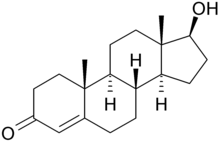User:Mr. Ibrahem/Hyperandrogenism
| Hyperandrogenism | |
|---|---|
| Other names | Androgen excess |
 | |
| Testosterone is a type of androgen that is important in the development of hyperandrogenism since high levels of it can cause this condition. | |
| Pronunciation |
|
| Specialty | Endocrinology |
| Symptoms | Acne, hair loss on scalp, increased body or facial hair, infrequent or absent menstruation[1][2] |
| Causes | Polycystic ovary syndrome (PCOS), adrenal hyperplasia, Cushing's disease, cancer[1][3] |
| Diagnostic method | Blood tests, ultrasound[1][4] |
| Treatment | Birth control pills, cyproterone acetate[1] |
| Frequency | 5% (reproductive age women)[2] |
Hyperandrogenism is a medical condition characterized by high levels of androgens in females.[4] Symptoms may include acne, seborrhea (inflamed skin), hair loss on the scalp, increased body or facial hair, and infrequent or absent menstruation.[1][2] Complications may include high blood cholesterol.[4]
The cause in about 70% of cases is polycystic ovary syndrome (PCOS).[1] Other causes include adrenal hyperplasia, Cushing's disease, certain types of cancers, and certain medications.[1][3][4] Diagnosis often involves blood tests for testosterone, 17-hydroxyprogesterone, and prolactin as well as a pelvic ultrasound.[1][4]
Treatment depends on the underlying cause.[4] Symptoms of hyperandrogenism can be improved with birth control pills or antiandrogens such as cyproterone acetate or spironolactone.[1][4] Other measures may include hair removal techniques.[3] It occurs in about 5% of women of reproductive age.[2]
The earliest known descriptions of the condition are by Hippocrates in the 5th century BCE.[5][6] In 2011 the International Association of Athletics Federations ruled that women must have testosterone levels below that of men to compete.[7] There are concerns that these rules are both unscientific and unfair.[7]
References[edit]
- ^ a b c d e f g h i Peigné, M; Villers-Capelle, A; Robin, G; Dewailly, D (November 2013). "[Hyperandrogenism in women]". Presse Médicale. 42 (11): 1487–99. doi:10.1016/j.lpm.2013.07.016. PMID 24184282.
- ^ a b c d Curtis, Michele; Antoniewicz, Leah; Linares, Silvia T. (2014). Glass' Office Gynecology. Lippincott Williams & Wilkins. p. 39. ISBN 9781608318209.
- ^ a b c Catteau-Jonard, S; Cortet-Rudelli, C; Richard-Proust, C; Dewailly, D (2012). "Hyperandrogenism in adolescent girls". Endocrine Development. 22: 181–93. doi:10.1159/000326688. ISBN 978-3-8055-9336-6. PMID 22846529.
- ^ a b c d e f g Carlson, Karen J.; Eisenstat, Stephanie A. (2004). The New Harvard Guide to Women's Health. Harvard University Press. p. 286. ISBN 9780674012820.
- ^ Banker, Manish (2019). Nova IVI Textbook of Infertility & Assisted Reproductive Technology. JP Medical Ltd. p. 237. ISBN 9789388958844.
- ^ Pathobiology of Human Disease: A Dynamic Encyclopedia of Disease Mechanisms. Elsevier. 2014. p. 1385. ISBN 9780123864574.
- ^ a b Burki, TK (October 2016). "Hyperandrogenism rule no longer in play at Rio Olympics". The Lancet. Diabetes & Endocrinology. 4 (10): 820. doi:10.1016/S2213-8587(16)30213-3. PMID 27503334.
